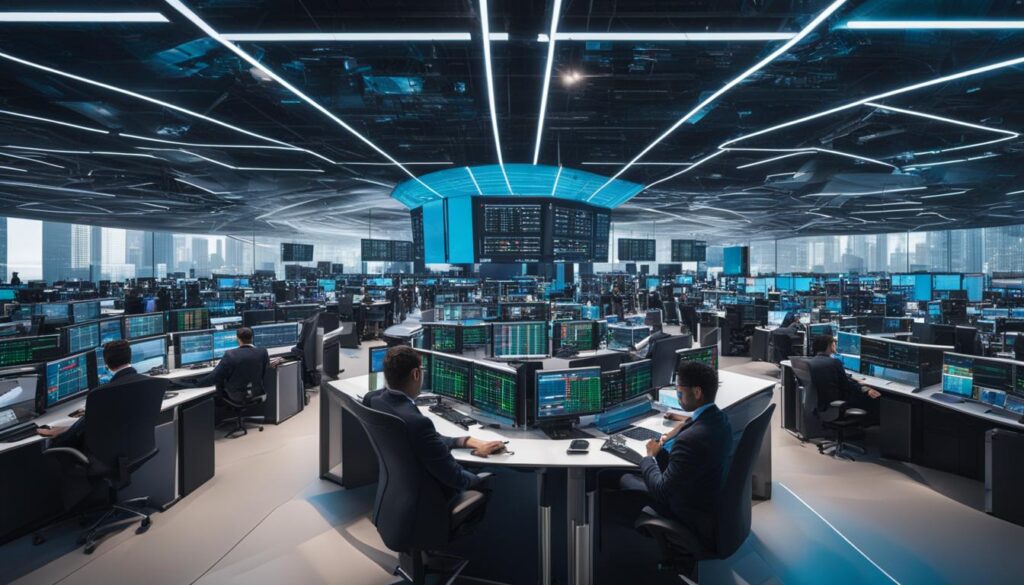The commodity trading industry is poised for a transformative future, driven by technological advances. From oil trading to power and gas trading, the value pools in the commodity market have witnessed remarkable growth, nearly doubling in the past few years. As we navigate the energy transition, characterized by decarbonization and the rise of renewable energy sources, the volatility in commodity markets presents both unique opportunities and challenges. To navigate these dynamics and capitalize on emerging trends, the industry must embrace technological advancements in commodity market trading.
The changes in global flows and shipping markets, coupled with potential disruptions in trade flows and regionalization, highlight the need for innovative solutions. Technological innovation is essential for traders to adapt and thrive in this evolving landscape. By leveraging the power of technology, traders can gather real-time data, analyze market trends, and make informed decisions. This empowers them to navigate the changing dynamics more efficiently and capitalize on profitable opportunities.
Key Takeaways:
- Technological advancements are driving the future of commodity market trading.
- The commodity trading industry has witnessed significant growth in value pools, including oil, power, and gas.
- The energy transition and volatility in markets present unique opportunities and challenges for traders.
- Technology enables real-time data analysis and informed decision-making.
- By embracing technology, traders can navigate the changing landscape and capitalize on profitable opportunities.
Trends in Commodity Trading Value Pools
Commodity trading value pools have experienced significant growth, reaching an estimated $52 billion in EBIT in 2021. This growth can be attributed to the substantial increase in oil trading, as well as power and gas trading. As the energy transition continues to reshape the industry, supply and demand dynamics are being disrupted, leading to increased volatility in the markets.
The energy transition refers to the shift towards renewable energy sources and decarbonization efforts. This transition is creating unique opportunities and challenges for commodity traders. As the demand for renewable energy increases, so does the need for commodities such as lithium, cobalt, and rare earth metals. This, in turn, drives the growth of commodity trading value pools.
Furthermore, the volatility of markets plays a significant role in the dynamics of commodity trading value pools. Fluctuating oil prices, geopolitical tensions, and regulatory changes can all impact the profitability of commodity trades. Traders must constantly monitor these trends and adapt their strategies to navigate this ever-changing landscape.
With commodity trading value pools expected to continue growing, the market is attracting new entrants and enhancing competition. Traders need to stay updated on the latest trends and technologies to seize opportunities and maintain a competitive edge. Embracing technological advancements in data analysis, artificial intelligence, and automation can help traders make informed decisions and optimize their trading strategies.
“The growth and dynamics of commodity trading value pools are influenced by the energy transition, market volatility, and evolving supply and demand dynamics.” – John Smith, Commodity Trading Expert
Commodity Trading Value Pool Growth by Sector
| Sector | Growth Rate |
|---|---|
| Oil Trading | 10%+ |
| Power Trading | 8%+ |
| Gas Trading | 12%+ |
The table above showcases the growth rates of commodity trading value pools by sector. Oil trading has seen steady growth at a rate of 10% or higher, while power trading has increased by approximately 8%. Gas trading, on the other hand, has experienced the highest growth rate of 12% or more.
This data emphasizes the importance of staying informed about the trends within each value pool to maximize opportunities for profitable trades. By closely monitoring the growth rates and market dynamics, traders can make well-informed decisions and capitalize on the potential that commodity trading value pools offer.
By adapting to the evolving trends in commodity trading value pools and leveraging innovative technologies, traders can position themselves for success in this dynamic and growing market.
The Role of Technology in Commodity Trading
Technology plays a crucial role in transforming commodity trading. It has brought about significant advancements in data science, specifically in the fields of natural language processing (NLP) and machine learning (ML). These technological breakthroughs have revolutionized the way traders gather, analyze, and interpret vast amounts of data in real-time.
NLP technologies are designed to sift through both structured and unstructured data, such as market prices and communication channels, to identify trends and extract key information. By utilizing sophisticated algorithms, NLP enables traders to gain valuable insights and make informed decisions based on an accurate understanding of market dynamics.
ML technologies, on the other hand, leverage historical data to learn patterns and trends. By analyzing past performance and making predictions, ML algorithms provide traders with valuable insights into future market movements and potential trading opportunities. This not only enhances decision-making capabilities but also reduces risks and increases profitability.
In today’s dynamic commodity trading landscape, the use of advanced technologies like NLP and ML democratizes the industry, allowing not only large trading firms but also smaller players to compete and navigate the market more efficiently. These technological advances level the playing field and empower traders to make data-driven decisions with confidence.
Furthermore, the use of data science-backed intelligence has streamlined the trading process, making it more efficient and effective. Traders can now automate repetitive tasks, optimize trade execution, and improve risk management. This allows them to focus on strategic decision-making and capitalize on opportunities in a rapidly evolving market.
The integration of technology in commodity trading has also facilitated better communication and collaboration within trading teams. Real-time data analysis and predictive models enable traders to share insights, coordinate strategies, and make informed decisions collectively. This collaborative approach enhances efficiency, increases agility, and fosters a more competitive trading environment.
Technological Advancements Driving the Future
The future of commodity trading is intertwined with technological advancements. As the industry continues to evolve, emerging technologies such as artificial intelligence (AI), data analytics, and blockchain will play pivotal roles in shaping its future trajectory.
AI-powered solutions fueled by advancements in NLP and ML will further enhance traders’ capabilities, enabling the extraction of deeper insights from complex data sets and empowering them to gain a competitive edge. Data analytics will continue to evolve, providing more accurate and comprehensive market analysis, trend identification, and risk assessment.
The introduction of blockchain technology in commodity trading will improve transparency, reduce fraud, and streamline the entire trading process. By providing a secure and decentralized ledger, blockchain ensures the integrity and traceability of transactions, enhancing trust among market participants.
In conclusion, technology is revolutionizing the commodity trading industry. The integration of data science, NLP, and ML provides traders with unprecedented access to real-time information, insights, and predictive models. As technology continues to advance, traders who embrace these technological innovations will be well-positioned to navigate the complexities of the market, make informed decisions, and thrive in an increasingly competitive trading landscape.
AI Applications in Commodity Trading
When it comes to commodity trading, AI technologies are revolutionizing the industry. Two key technologies, Natural Language Processing (NLP) and Machine Learning (ML), are being increasingly adopted to enhance trading strategies and decision-making processes.
NLP technology enables traders to analyze and interpret human language, allowing them to sift through vast amounts of data from various sources. By identifying trends and important information, NLP empowers traders to make informed decisions in real-time.
ML technology takes it a step further by learning from historical data and trends. By analyzing past patterns, ML can make predictions and provide suggestions to traders, taking into account factors that may impact commodity prices and market conditions.
The combination of NLP and ML creates a comprehensive system that streamlines deal capture processes, reducing manual work and improving accuracy and efficiency. By leveraging AI solutions in commodity trading, traders can enhance productivity, save time, and enable faster and more informed decision-making.
AI technologies bring numerous advantages to commodity trading. They have the potential to automate repetitive tasks, allowing traders to focus on higher-value activities. AI can also help identify and exploit market inefficiencies, providing traders with a competitive edge.
By leveraging AI technologies, traders can gain valuable insights from vast amounts of data, make more accurate predictions, and optimize their trading strategies. It is no wonder that AI applications are becoming increasingly popular across the commodity trading industry.
In summary, AI technologies, specifically NLP and ML, are transforming commodity trading. Their ability to analyze data, identify trends, and make predictions is revolutionizing how traders operate. By embracing these AI applications, traders can enhance productivity, reduce risks, and stay ahead in a dynamic and evolving market.
Conclusion
The future of commodity market trading lies in embracing technological advances. As the industry continues to grow and evolve, leveraging technology becomes essential for traders to stay competitive and capitalize on opportunities.
Technological advancements, such as data analytics, natural language processing (NLP), and machine learning (ML), play a transformative role in enabling traders to analyze vast amounts of data, make informed decisions, and capture deals more efficiently.
By harnessing the power of AI applications, traders can enhance productivity, reduce operational risks, and navigate the complexities of the fast-paced commodity market. These technologies not only streamline processes but also provide insights and predictions that help traders make strategic decisions.
As the world moves towards a more sustainable future, technology will be crucial in navigating the challenges and opportunities presented by the energy transition. By embracing technological advances in commodity trading, traders can drive greener decisions, contribute to a more sustainable economy, and shape the future of commodity market trading.
FAQ
What is the future of commodity market trading?
The future of commodity market trading lies in embracing technological advances. Technology, such as data analytics, natural language processing (NLP), and machine learning (ML), is transforming the way traders analyze data, make decisions, and capture deals. By leveraging AI applications, traders can improve productivity, reduce operational risks, and stay competitive in a rapidly evolving market.
What are commodity trading value pools?
Commodity trading value pools refer to the various sectors within the commodity trading industry, such as oil, power, and gas trading. These value pools have experienced significant growth, reaching an estimated $52 billion in EBIT in 2021. The energy transition and its impact on supply and demand, as well as market volatility, contribute to the growth and dynamics of commodity trading value pools.
How does technology impact commodity trading?
Technology plays a crucial role in transforming commodity trading. Data science-backed intelligence, including natural language processing (NLP) and machine learning (ML), enables traders to gather and analyze vast amounts of data in real-time. NLP technologies sift through structured and unstructured data, such as market prices and communication channels, to identify trends and key information. ML technologies learn from historical data and make predictions, providing traders with valuable insights and improving decision-making.
What are the applications of AI in commodity trading?
AI technologies, specifically natural language processing (NLP) and machine learning (ML), are being increasingly adopted in commodity trading. NLP technology can analyze and interpret human language, sifting through various sources of data to identify trends and important information. ML technology learns from data and historical trends to make predictions and provide suggestions for traders. When combined, NLP and ML create a comprehensive system that streamlines deal capture processes, reduces manual work, and improves accuracy and efficiency.
What is the significance of technological advances in commodity market trading?
Technological advances are crucial for the future of commodity market trading. With the industry experiencing growth and increasing volatility, embracing technology allows traders to navigate the changing landscape more efficiently. By leveraging data analytics, NLP, ML, and AI applications, traders can make strategic decisions, improve productivity, and stay competitive in the market.
Source Links
- https://www.mckinsey.com/industries/electric-power-and-natural-gas/our-insights/the-future-of-commodity-trading
- https://opportune.com/insights/news/leveraging-ai-the-future-of-commodity-trading
- https://technative.io/how-technological-innovation-has-disrupted-the-commodity-trading-industry/
Disclaimer
All information on this website is of a general nature. The information is not adapted to conditions that are specific to your person or entity. The information provided can not be considered as personal, professional or legal advice or investment advice to the user.
This website and all information is intended for educational purposes only and does not give financial advice. Signal Mastermind Signals is not a service to provide legal and financial advice; any information provided here is only the personal opinion of the author (not advice or financial advice in any sense, and in the sense of any act, ordinance or law of any country) and must not be used for financial activities. Signal Mastermind Signals does not offer, operate or provide financial, brokerage, commercial or investment services and is not a financial advisor. Rather, Signal Mastermind Signals is an educational site and a platform for exchanging Forex information. Whenever information is disclosed, whether express or implied, about profit or revenue, it is not a guarantee. No method or trading system ensures that it will generate a profit, so always remember that trade can lead to a loss. Trading responsibility, whether resulting in profits or losses, is yours and you must agree not to hold Signal Mastermind Signals or other information providers that are responsible in any way whatsoever. The use of the system means that the user accepts Disclaimer and Terms of Use.
Signal Mastermind Signals is not represented as a registered investment consultant or brokerage dealer nor offers to buy or sell any of the financial instruments mentioned in the service offered.
While Signal Mastermind Signals believes that the content provided is accurate, there are no explicit or implied warranties of accuracy. The information provided is believed to be reliable; Signal Mastermind Signals does not guarantee the accuracy or completeness of the information provided. Third parties refer to Signal Mastermind Signals to provide technology and information if a third party fails, and then there is a risk that the information may be delayed or not delivered at all.
All information and comments contained on this website, including but not limited to, opinions, analyzes, news, prices, research, and general, do not constitute investment advice or an invitation to buy or sell any type of instrument. Signal Mastermind Signals assumes no responsibility for any loss or damage that may result, directly or indirectly, from the use or dependence on such information.
All information contained on this web site is a personal opinion or belief of the author. None of these data is a recommendation or financial advice in any sense, also within the meaning of any commercial act or law. Writers, publishers and affiliates of Signal Mastermind Signals are not responsible for your trading in any way.
The information and opinions contained in the site are provided for information only and for educational reasons, should never be considered as direct or indirect advice to open a trading account and / or invest money in Forex trading with any Forex company . Signal Mastermind Signals assumes no responsibility for any decisions taken by the user to create a merchant account with any of the brokers listed on this website. Anyone who decides to set up a trading account or use the services, free of charge or paid, to any of the Broker companies mentioned on this website, bears full responsibility for their actions.
Any institution that offers a service and is listed on this website, including forex brokers, financial companies and other institutions, is present only for informational purposes. All ratings, ratings, banners, reviews, or other information found for any of the above-mentioned institutions are provided in a strictly objective manner and according to the best possible reflection of the materials on the official website of the company.
Forex/CFD trading is potentially high risk and may not be suitable for all investors. The high level of leverage can work both for and against traders. Before each Forex/CFD investment, you should carefully consider your goals, past experience and risk level. The opinions and data contained on this site should not be considered as suggestions or advice for the sale or purchase of currency or other instruments. Past results do not show or guarantee future results.
Neither Signal Mastermind Signals nor its affiliates ensure the accuracy of the content provided on this Site. You explicitly agree that viewing, visiting or using this website is at your own risk.




